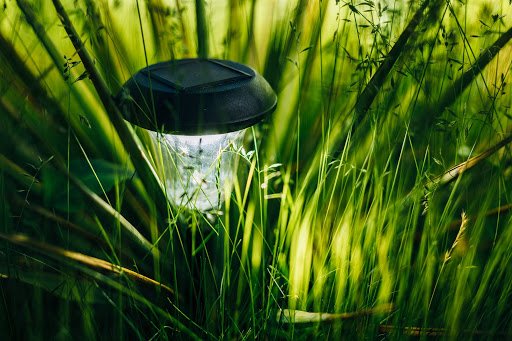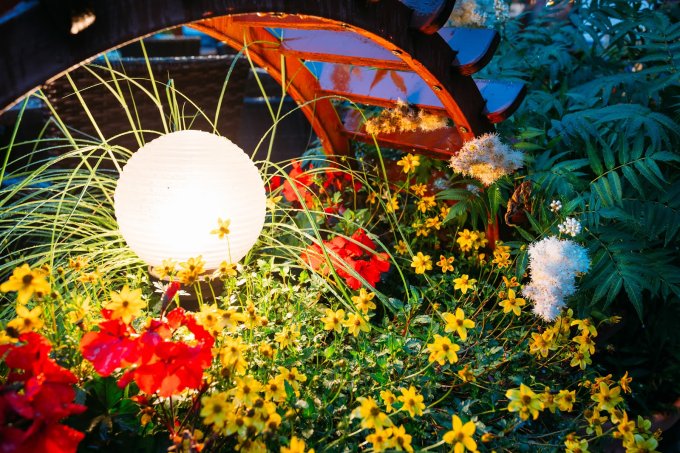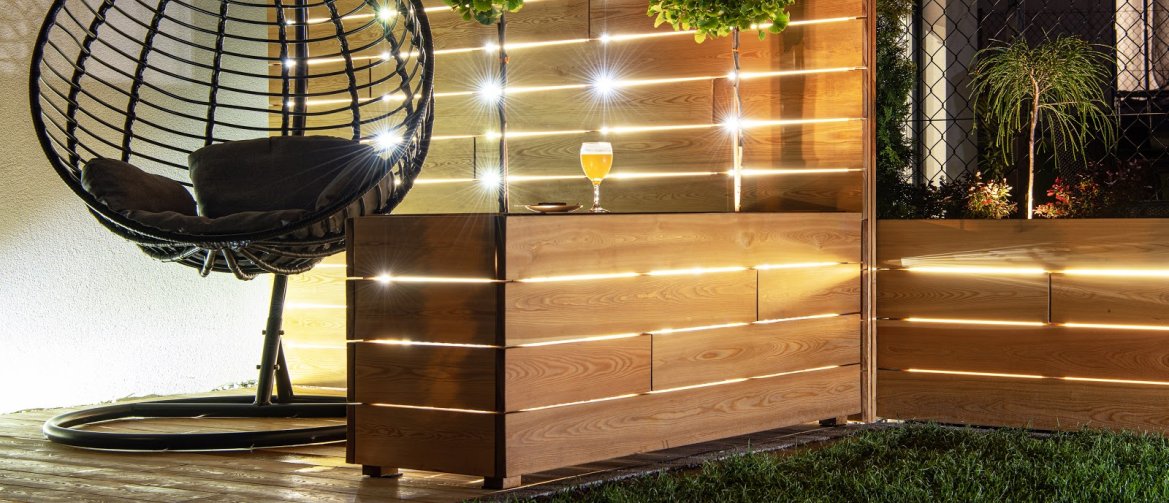Garden Lights - How To Choose The Best Ones?
Choosing the right outdoor lights is serious business - not only should it illuminate your house and all its surroundings at night, but also harmonize well with the landscape arrangement. It's especially difficult, if you don't have any idea where to start. That's the reason we've decided to write this guide. Here's some basic info on what you should know while choosing perfect lights for your garden.
Where to start with garden lighting?
There are two main issues to be addressed here - what's the goal of your garden lighting and whether there's enough space for the lights.
Determining the purpose of your garden lighting
Due to vast quantities of possible lighting options, it's recommended to consider what you want from your outdoor lighting. This will give you the starting point for tracking the right products. For example, if you need security lights, solar-powered spike lights can be scratched off the list. To make things easier, try breaking your outdoor space down into zones, as different parts of the garden require different types of outdoor lighting.
Checking the available space
When you have a solid idea of what you'll need, it's time to determine if you actually have enough outdoor space to put the light in. Always check a product's dimensions and make sure it'll fit before buying. For example, putting a floodlight behind a drain pipe rather misses the point. Even a few centimetres can make a huge difference - shifting a wall light just a bit down will affect the lighting effects greatly.
If you settle for stake lights, make sure that the ground is soft enough to install them. You can simply push a stick or a cane into the ground and see how far it goes in. Without that, you can get really frustrated when your lights won't stay in the ground properly. It's a simple precaution that can save you a lot of time overall.

Types of outdoor lights and where to put them
As we already mentioned, there's a plethora of options when it comes to outdoor lighting. Here's six main types of garden lighting and best locations to put them in:
Pathway lights
Their main goal is to ensure safety on paths, driveways, around water and potential obstacles. They also work well for illuminating flowerbeds, benches, and garden furniture. This category includes lamps such as:
- - stake/spike lights,
- - post lights,
- - bollard lights.
Floodlights
They provide wide light beams ideal for illuminating larger patches of lawn, flower gardens, big driveways or the home walls. They can be ground- or surface-mounted (e.g., on walls) and work for both safety and security.
Spotlights
In contrast to floodlights, their beams are rather narrow, which makes them great for accenting a specific location like entrance, gazebo, patio, or a particularly interesting feature, e.g., large, majestic tree or a fancy sculpture.
String/festoon lights
Festoon lights and string lights (a.k.a. fairy lights) consist of long cables with light bulbs attached along their length (at regular intervals). String lights in general have smaller, fixed bulbs, while festoons use bigger (sometimes “regular”), individually replaceable, light bulbs. Both types are mainly used for mood and ambient lighting, but strings are a bit more versatile - they can even be used for illuminating single trees/bushes, while festoons work better for larger spaces.

Wall/facade lights
They are one of the most decorative/stylish lamps that can be installed in gardens, both modern and traditional-styled. Those wall-mounted lights can be used on the home's outside walls, porches, patios, gazebos, garden walls and fences. The only downside to wall lights is that they are mostly mains powered, so their installation requires some electrical expertise.
Deck lights
They come in many forms - from surface-mounted strip lights, to recessed lights that can be slotted into the decking's surface (or ground, depending on the model). Thanks to their low profile, they keep the area well lit (washing it with soft glow) while staying out of sight. They are used for illuminating patios, gazebos, garden steps, any other decking, walkways and driveways (although you'll need to get models with high pressure resistance for them to withstand the weight of a car).
Most of the mentioned types (in LED variant) can be found at https://lucasled.ie/led-garden-lights.
Things to consider while browsing for garden lights
Knowing which lighting option you'd like for your garden is just one of the parameters you should consider before you buy any outdoor lights. Here are the main ones (in more or less random order):
Light source
The type of bulb used impacts everything from the light's longevity to energy consumption. By far the best option is to choose LED lights - they're the most cost-effective and energy-efficient light sources available right now. Plus, their lifespan is at least 10x longer than that of halogens and at least 20x longer than incandescent bulbs'. Sure, they aren't cheap, but they'll save you a lot in the long run, especially if you decide to install many mains-powered lamps.
Power source
The power source impacts what you can do with your lights. There are three options here - mains, battery-powered and solar lights.
Mains-powered lighting works best for permanent fixtures placed close to the house, e.g., wall lights. It'll give off the brightest, consistent light, which makes it the most reliable option. Unfortunately, it's also the hardest to install - in many cases you'll need the help of a professional electrician - and adds to your electrical bills.
Battery-powered lights are highly portable and can be moved around effortlessly. They vary in shapes and sizes, so it's rather easy to find the right ones for the occasion. They have one major disadvantage - their batteries have rather short lifespans, so you'd have to replace them often. This makes them unsuited for task lighting - they work far better for occasional, decorative purposes, e.g., during outdoor parties.
Solar-powered lighting is a sort of compromise between the two aforementioned options. It is still easy to install and portable while being quite reliable - the batteries charge during the day and don't need frequent replacing. It also turns on automatically when the sun goes down, which makes it the most convenient for low-maintenance outdoor lighting systems. The catch is its brightness depends on the amount of solar energy accumulated during the day, so it's not the best for shady gardens and locations with shorter days.
Activation method
Mains-powered lighting can be turned on and off in three different ways - by manual switch, PIR (passive infra-red) motion sensor or ‘dusk till dawn’ sensor. It's mostly the matter of convenience - flipping a switch is easy, but you can forget to turn the light off during the day; PIR activates only when there's movement detected, but can pick up animals or even people in neighbouring gardens; the DTD sensors will keep the lighting on throughout the night and turn it off when there's enough natural light, making it by far the best option for low-maintenance gardens (similar to solar-powered fixtures).
You should also remember that some mains lighting fixtures (e.g., deck ones) require IP rated switches/sockets (65 would be perfect).

IP rating
Any outdoor lighting should be good at withstanding the elements. But how can you measure that? That's what IP (Ingress Protection) ratings are for. They consist of two numbers - the first one indicates the level of protection against solid objects, while the second refers to water protection.
The first scale goes from 0 (not protected) to 6 (fully dust-tight) and the second one goes from 0 to 8 (fully waterproof and able to be submerged to depths of up to one metre).
An absolute minimum for outdoor use is an IP44. Lamps and fixtures with this rating are protected against objects sized 1 mm and up, while being able to withstand splashes of water. An optimal IP for outdoor fixtures would be 65 - they can withstand anything that British weather can throw at it. Lamps with waterproofing of 5+ are only needed for places exposed to heavy amounts of water and aren't all that common.
Brightness
To put it simply - brightness (measured in lumens) dictates the light's purpose and is especially important for LED outdoor lighting. For example, security lamps should be very bright, while path lights may be rather dim as they only need to give you an outline of the walkway.

Light's colour
This isn't just a decorative feature - the light's colour greatly impacts the feel of a given space. For example, multicoloured fairy lights will create a more festive atmosphere, while a warm white lighting will not only illuminate your patio, but also make it feel really cosy.
What do we mean by warm light? Colour temperature (measured in Kelvins) is another important characteristic of light. Unfortunately, it's often overlooked, which is a great shame. This determines how ‘warm’ (yellow) or ‘cool’ (blue) a white light appears to be. It's a bit tricky because the higher the temperature, the cooler the light is (which might seem counterintuitive at first).
For example, a colour temperature of 2700K means a warm, yellowy light, ideal for relaxation areas. A colour temperature of 4000K corresponds to a cooler, white light, while lighting with 6500K will have a bluer hue to it (similar to natural daylight), which is best suited for task lighting.
Transform your garden with LED lights
When you're looking for perfect garden lighting, LEDs are by far the best option - no matter if they draw power from a battery, sun, or your home's electrical grid. Their longevity, diversity, and low-level energy consumption makes them perfect for any outdoor lighting installation - you can design practically anything with them, both inside and outside your home.
External partner's article
Vide!

Underestimated compensation from the civil...
A car accident in itself is a very unpleasant event, but unpleasant situations do not end there. If...

How much can you earn while working on the...
Working from home or elsewhere on the internet has become one of the most popular types of work...

We're starting to build e-business
One of the most frequently committed (despite warnings from e-business experts) is to start a...




